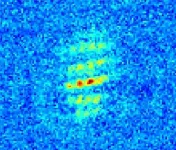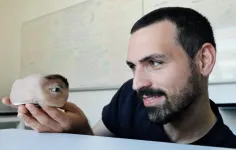Study suggests common drug could be used to prevent certain skin cancers
2021-04-13
(Press-News.org) COLUMBUS, Ohio ¬- New data published by researchers at The Ohio State University Comprehensive Cancer Center - Arthur G. James Cancer Hospital and Richard J. Solove Research Institute (OSUCCC - James) suggests that an oral drug currently used in the clinical setting to treat neuromuscular diseases could also help prevent a common form of skin cancer caused by damage from ultraviolet-B (UVB) radiation from the sun.
While this data was gathered from preclinical studies, senior author Sujit Basu, MD, PhD, says preliminary results in animal models are very promising and worthy of immediate further investigation through phase I human studies.
Basu and his colleagues reported their initial findings online ahead of print April 12 in Cancer Prevention Research, a journal of the American Association for Cancer Research.
According to the American Cancer Society, more than 5.4 million basal and squamous cell skin cancers are diagnosed annually in the United States. The disease typically recurs throughout a person's lifetime, and advanced disease can lead to physical disfiguration. These cancers are linked to the sun's damaging rays, and despite increased public awareness on sun safety precautions, rates of the disease have been increasing for many years.
Previous peer-reviewed, published studies have shown that dopamine receptors play a role in the development of cancerous tumors; however, their role in precancerous lesions is unknown.
In this new study, OSUCCC - James researchers report data showing that the neurotransmitter/neurohormone dopamine, by activating its D2 receptors, can stop the development and progression of certain UVB-induced precancerous squamous skin cancers. Researchers also describe the molecular sequence of events that leads to cancer suppression.
"Cancer control experts have been stressing the importance of reducing exposure to the sun and practicing sun-safe habits for many years, but scientific data shows us that cumulative damage of UV rays ultimately leads to skin cancer for many people. Finding better ways to prevent these cancers from developing is critical to reduce the global burden of this disease," says Basu, a researcher with the OSUCCC - James Translational Therapeutics Research Program and a professor of pathology at The Ohio State University College of Medicine.
"Our study suggests that a commonly used drug that activates specific dopamine receptors could help reduce squamous cell skin cancer recurrence and possibly even prevent the disease entirely. This is especially exciting because this is a drug that is already readily used in clinical settings and is relatively inexpensive. We are excited to continue momentum in this area of research," adds Basu.
The OSUCCC - James is working on plans to begin further testing in a phase I experimental clinical trial in the coming months.
INFORMATION:
This study was supported by grants from the U.S. Department of Defense and National Institutes of Health. Co-authors include Kai Lu, Madhavi Bhat, Sara Peters, Xiaokui Mo and Tatiana Oberyszyn of Ohio State; Rita Mitra of KPC Medical College and Partha Sarathi Dasgupta of Chittaranjan National Cancer Institute.
About the OSUCCC - James
The Ohio State University Comprehensive Cancer Center - Arthur G. James Cancer Hospital and Richard J. Solove Research Institute strives to create a cancer-free world by integrating scientific research with excellence in education and patient-centered care, a strategy that leads to better methods of prevention, detection and treatment. Ohio State is one of 51 National Cancer Institute (NCI)-designated Comprehensive Cancer Centers and one of only a few centers funded by the NCI to conduct both phase I and phase II clinical trials on novel anticancer drugs sponsored by the NCI. As the cancer program's 356-bed adult patient-care component, The James is one of the top cancer hospitals in the nation as ranked by U.S. News & World Report and has achieved Magnet® designation, the highest honor an organization can receive for quality patient care and professional nursing practice. With 21 floors and more than 1.1 million square feet, The James is a transformational facility that fosters collaboration and integration of cancer research and clinical cancer care. To learn more, visit cancer.osu.edu.
ELSE PRESS RELEASES FROM THIS DATE:
2021-04-13
Studies show wearing masks and social distancing can contain the spread of the COVID-19 virus, but their combined effectiveness is not precisely known.
In Chaos, by AIP Publishing, researchers at New York University Tandon School of Engineering and Politecnico di Torino in Italy developed a network model to study the effects of these two measures on the spread of airborne diseases like COVID-19. The model shows viral outbreaks can be prevented if at least 60% of a population complies with both measures.
"Neither social distancing nor mask wearing alone are likely sufficient to halt the spread of COVID-19, unless almost the entire population adheres to the single measure," author Maurizio Porfiri said. "But if a significant fraction of the ...
2021-04-13
Extremely precise measurements are possible using atom interferometers that employ the wave character of atoms for this purpose. They can thus be used, for example, to measure the gravitational field of the Earth or to detect gravitational waves. A team of scientists from Germany has now managed to successfully perform atom interferometry in space for the first time - on board a sounding rocket. "We have established the technological basis for atom interferometry on board of a sounding rocket and demonstrated that such experiments are not only possible on Earth, but also in space," said Professor Patrick Windpassinger of the Institute of Physics at Johannes Gutenberg University Mainz (JGU), whose team was involved in the investigation. The results of their analyses have been ...
2021-04-13
Scientists at the Walter Reed Army Institute for Research demonstrated the potential of a novel blood test for cathepsin B, a well-studied protein important to brain development and function, as an indicator for a range of disease states.
Cathepsin B plays an important role in the body, regulating the metabolism, immune responses, degradation of improperly produced proteins and other functions. Under certain conditions, such as metastatic cancers, infections, trauma and neurological disease, cathepsin B production is upregulated. Recent research published by WRAIR researchers highlighted the potential of cathepsin B as an indicator, or biomarker, of the severity of traumatic brain injury.
In this study, published in ACS Omega, researchers demonstrated an ultrasensitive ...
2021-04-13
It cannot be denied that, over the past few decades, the miniaturization of electronic devices has taken huge strides. Today, after pocket-size smartphones that could put old desktop computers to shame and a plethora of options for wireless connectivity, there is a particular type of device whose development has been steadily advancing: wearable biosensors. These tiny devices are generally meant to be worn directly on the skin in order to measure specific biosignals and, by sending measurements wirelessly to smartphones or computers, keep track of the user's health.
Although materials scientists have developed many types ...
2021-04-13
Researchers from North Carolina State University have found a way to fine-tune the molecular assembly line that creates antibiotics via engineered biosynthesis. The work could allow scientists to improve existing antibiotics as well as design new drug candidates quickly and efficiently.
Bacteria - such as E. coli - harness biosynthesis to create molecules that are difficult to make artificially.
"We already use bacteria to make a number of drugs for us," says Edward Kalkreuter, former graduate student at NC State and lead author of a paper describing the ...
2021-04-13
University of Maryland School of Medicine (UMSOM) researchers have shown that psilocybin--the active chemical in "magic mushrooms"-- still works its antidepressant-like actions, at least in mice, even when the psychedelic experience is blocked. The new findings suggest that psychedelic drugs work in multiple ways in the brain and it may be possible to deliver the fast-acting antidepressant therapeutic benefit without requiring daylong guided therapy sessions. A version of the drug without, or with less of, the psychedelic effects could loosen restrictions on who could receive the therapy, and lower costs, making the benefits of psilocybin more available to more people in need.
In all clinical ...
2021-04-13
The "three-body problem," the term coined for predicting the motion of three gravitating bodies in space, is essential for understanding a variety of astrophysical processes as well as a large class of mechanical problems, and has occupied some of the world's best physicists, astronomers and mathematicians for over three centuries. Their attempts have led to the discovery of several important fields of science; yet its solution remained a mystery.
At the end of the 17th century, Sir Isaac Newton succeeded in explaining the motion of the planets around the sun through ...
2021-04-13
PLYMOUTH MEETING, PA [April 13, 2021] -- The April 2021 issue of JNCCN--Journal of the National Comprehensive Cancer Network publishes new research from Memorial Sloan Kettering Cancer Center (MSK) and Gustave Roussy Institute, which suggests that baseline brain imaging should be considered in most patients with metastatic kidney cancer. The researchers studied 1,689 patients with metastatic renal cell carcinoma (mRCC) who had been considered for clinical trial participation at either of the two institutions between 2001 and 2019 and had undergone brain imaging in this context, without clinical suspicion for brain involvement. The researchers discovered 4% had asymptomatic brain metastases in this setting. This group was found to have a low median 1-year ...
2021-04-13
ITHACA, N.Y. - We've all seen them: political ads on television that promise doom gloom if Candidate X is elected, and how all your problems will be solved if you choose Candidate Y. And Candidate Y, of course, approves this message.
Beyond attempting to move a large swath of the population to vote one way or another, the seemingly constant bombardment of negativity in the name of our democratic process is anxiety-inducing, researchers have found.
"Many of my friends and family members wind up quite stressed out, for lack of a better word, during each election season," said Jeff Niederdeppe, professor in the Department of Communication in the College of ...
2021-04-13
With 'Eyecam' they now present the prototype of a webcam that not only looks like a human eye, but imitates its movements realistically. "The goal of our project is not to develop a 'better' design for cameras, but to spark a discussion. We want to draw attention to the fact that we are surrounded by sensing devices every day. That raises the question of how that affects us," says Marc Teyssier. In 2020, the French scientist completed his doctorate on the topic of anthropomorphic design in Paris. Now he is a postdoctoral researcher in the Human-Computer Interaction Lab at Saarland University in Germany.
The research team at Saarland Informatics Campus has developed ...
LAST 30 PRESS RELEASES:
[Press-News.org] Study suggests common drug could be used to prevent certain skin cancers


